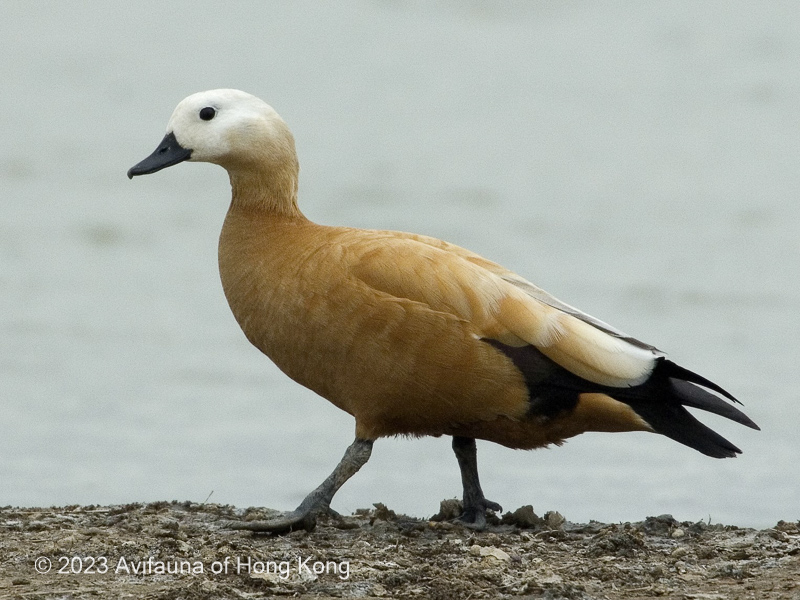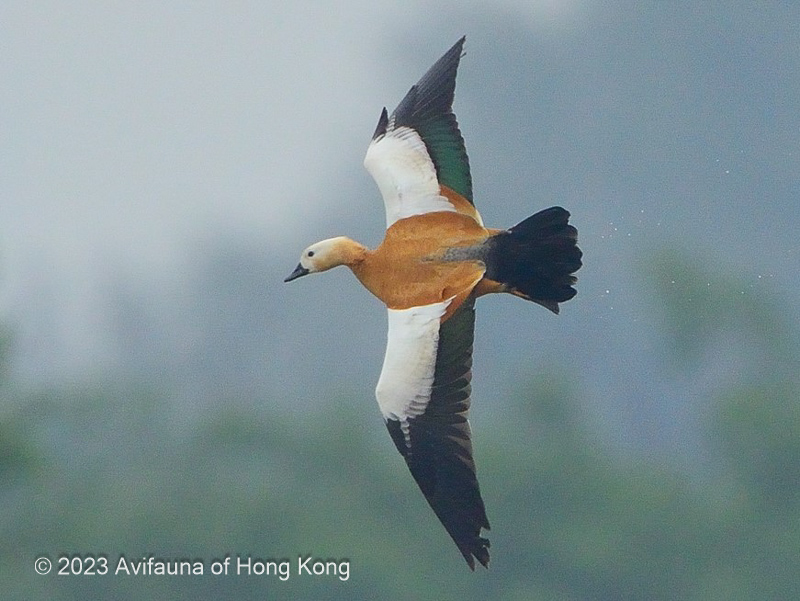Ruddy Shelduck Tadorna ferruginea 赤麻鴨
Category I. Rare winter visitor to Deep Bay area, mainly in the first part of the year
IDENTIFICATION

Apr. 2007, Kinni Ho. Female.
58-70 cm. Similar in size or slightly larger than Common Shelduck with more drawn-out rear end. Rich orange upperparts and underparts, paler buff head and, in adult male, a black neck ring separating the two areas. Female lacks neck collar and has more contrasting white face mask.

Dec. 2013, Kinni Ho. First-winter.
In flight white upperwing coverts (greyish-tinged on first-winter birds such as this) contrast with blackish flight feathers, rump and tail.

Apr. 2007, Kinni Ho. Female.
Underwing pattern mirrors that of the upperwing.
VOCALISATIONS
Ruddy Shelduck has a loud and rather nasal, inflected call, and may also utter a throaty rolling sound.
DISTRIBUTION & HABITAT PREFERENCE
Ruddy Shelduck has only been seen in the Deep Bay area, mostly at Mai Po NR but occasionally on both active and abandoned commercial fish ponds.
OCCURRENCE
First recorded on 4 November 1979, Ruddy Shelduck occurred in nine winters from 1979-80 to 1993-94. Since then, it has been recorded in only one in three winter periods. Apart from 1988-89 when up to seven birds were present, most records have involved singles, the exceptions being up to three during 2-4 January 2014 and two on 27 February 2016.
Extreme dates are 10 October 2021 and 14 May 2005. There are three spring records: a long-staying individual in 1986 present from at least mid-March, and singles during 14-24 April 2007 and 10-14 May 2005. All other records, however, have been in the period up to 31 March.
RANGE & SYSTEMATICS
Monotypic. Breeds in a wide range of habitats and altitudes from the Black Sea east to northeast China in the north and southwest China in the south; winters to the south from east and south China west through northern Indochina and the Indian subcontinent to northeast Africa, with resident populations present in northwest Africa, northwest Europe and southeast Europe (Salvador and Amat 2021). In China breeds on the Qinghai-Tibetan Plateau into Nei Mongol and northeast China and winters south of the Yangtze (Liu and Chen 2021).
Although generally indicated as wintering throughout southern China, it would seem from the paucity of records in HK that wintering this far south is relatively unusual. La Touche (1931-34) stated that he had not recorded it in Guangdong and that it was rare in Fujian. It seems likely that the milder winters occurring as a result of global heating will mean this species may become increasingly rare.
BEHAVIOUR, FORAGING & DIET
No observations.
CONSERVATION STATUS
IUCN: Least Concern. Population trend unknown.
La Touche, J. D. D. (1931-34). Handbook of the birds of Eastern China Vol. 2. Taylor and Francis, London.
Salvador, A. and J. A. Amat (2021). Ruddy Shelduck (Tadorna ferruginea), version 2.0. In Birds of the World (S. M. Billerman and M. A. Bridwell, Editors). Cornell Lab of Ornithology, Ithaca, NY, USA. https://doi.org/10.2173/bow.rudshe.02
Liu, Y. and S. H. Chen (eds) (2021). The CNG Field Guide to the Birds of China (in Chinese). Hunan Science and Technology Publication House, Changsha.

